| NEWS |
|
|
| BADGES |
|
|
| ROMFORD DISTRICT |
|
|
| FEATURES |
|
|
| SONGS |
|
|
| FORMS |
|
|
| LINKS |
|
|
| WEB SITE |
|
|
|
 |
 |
1933 - THE BEGINNING |
|
|
The early history of 3GP is bound up with the history of St Michael's and to an extent the history of Gidea Park.
The St Michael’s Mission Church was built in 1928 and until 1931 was within the Chapelry of All Saints Squirrels Heath. St Michael's is located in the Gidea Park Garden Suburb which was built between 1910 and the mid 1930s on parts of the old Gidea Hall estate. The old Gidea Hall was used as a sort of community centre and it was here that in 1926 the 1st Gidea Park Scouts started meeting.
When Gidea Hall was demolished in 1930, the 1st Gidea Park moved to All Saints Squirrels Heath which at the time was located on the North East side of the junction between Upper Brentwood Road and Squirrels Heath Lane. In 1933 they were evicted from there, moving even further away from the Gidea Park Estate to Salisbury Road School - now known as Squirrels Heath School.
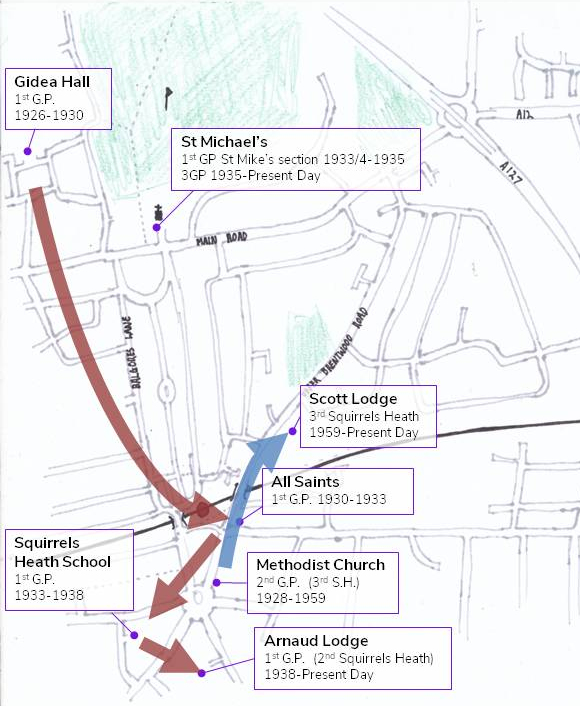 MAP NOT AT ALL TO ANY KIND OF SCALE MAP NOT AT ALL TO ANY KIND OF SCALE
At about the same time, St Michael's became a parish church in its own right when the new Parish of St Michael's Gidea Park was constituted. A new church hall was built and opened in 1933. The then Vicar of St Michael's Rev J Elvin made an application to the Scout's Local Association (similar to the modern District) for the registration and formation of a new Scout Troop at the Church, which would meet in the new Church Hall. That application was refused!
The District insisted that St Michael's could not have its own “closed” Scout Group on its own terms, despite the application containing a nominee for the warrant of Scouter in Charge who was an old Scout and who had been on the staff at Gilwell (Scouting headquarters).
Scouting at St Michael’s would have to take place under the auspices of the 1st Gidea Park who would open a St Michael’s section to compliment their Salisbury Road School section. It would therefore be a non sponsored open Group.
The reasoning for this was not clear but at the time the suspicion was that the 1st Gidea Park wanted the new St Michael's church hall as their own headquarters. Senior members of the Local Association executive were from the 1st Gidea Park. So Scouting at St Michael's started with the leaders of the 1st Gidea Park in charge. The 1st GP report that appeared in the 1934 District year book included the following:
| The most important features of our year of campaign have been (i.) The growth of the Headquarters Fund, and
(ii.) The growth in our numbers due to the formation of St. Michael's section. The St. Michael's section is progressing very well indeed under the care of A.S.M. (in charge) R. Tilston and A.S.M. F. Rowswell, who is taking charge of the Cubs. |
|
|
|
 |
 |
|
 |
 |
 |
THE PEOPLE OF 3GP - F. W. ROWSWELL |
|
|
This is the first mention of Mr Rowswell, a character who would have a huge and positive influence on Scouting at St Michael's over the next thirty years or more. At the time Freddie Rowswell was a Sunday School teacher at St Michael's. In his own words...
This was the position when I first took a hand in January 1934 as an ASM (Assistant Scout Master) , having previously held a warrant as GSM (Group Scout Master) in Portsmouth. I helped both the controlling Group and the St Michaels section for a year in both the Pack and the Troop, and joined the Rover Crew and took the combined Troop to camp at Botley, Hampshire, in July.
But it was readily apparent that the St Michaels section urgently needed re-registration as a separate group. This view was also held by W.Nicholass, another ASM introduced to the Group and the section. |
We have the below picture in the Group archives dated 1933 showing Freddie Rowswell centre, along with the Patrol Leaders of the 54th Portsmouth Hilsea College Troop. Hilsea College was originally a Portsmouth-based boarding college for naval officer's children. The School is now known as the Trafalgar School, Hilsea,
Portsmouth but the buildings in the picture below are still recognisable from the school field today. The 54th can't have fared too well after Freddie's departure as the current 54th Portsmouth seems to have been started in 1946.
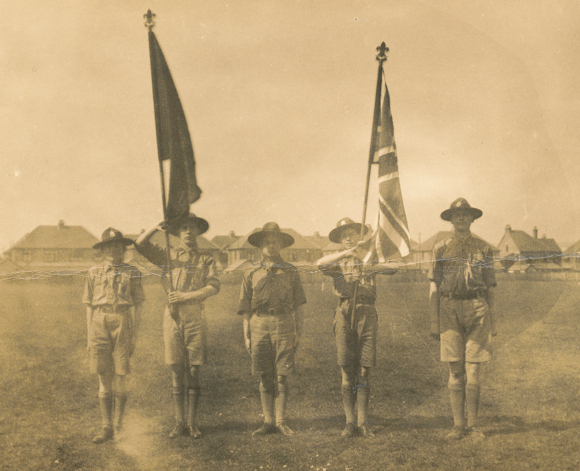
We have a copy of F.W.Rowswell's Warrant for the role of G.S.M. of 3rd Gidea Park from 1/6/1948 to 8/11/1966.
In our original register of Scouts, the front page lists the Group officers, Rev J Elvin being the GSM and Frederick William Rowswell being the Cub Master as of October 1935. His entry is as follows:
Occupation: Schoolmaster Brentwood School, Essex, B.A. London University M.R.S.T (Member of the Royal Society of Teachers).
Formally
GSM 54th Portsmouth (Hilsea College) 1932-1933
ASM 1st Gidea Park 1934-35
Interpreter in French, Spanish, Portuguese, Italian, German, Latin, Romanian and Russian.
Assistant to International Bureau (translator)
Honouree Member of 4th Gibraltar
ASM of Brentwood School troop from 1937
By 1941 he was elected to the Romford Local Association executive committee in the role of Secretary for Press, Publicity and Propaganda!
There is a Letter from Derek Rowswell in our Group Archives. At the time of writing the letter, Derek was helping with a troop before being posted outside Lusaka, the capitol of Zambia. One of the Scouts was the son of President Kaurda. Kenneth Kaunda was president of Zambia for 27 years from 1964 to 1991 and had a few sons so dating this undated letter is a challenge. Derek signs off with "hoping your new job in Portsmouth is to your liking" so it looks as if FWR returned to Portsmouth after his time in Gidea Park and Brentwood School.
|
|
|
 |
 |
|
 |
 |
 |
1934 to 1935 - GROUP REGISTRATION |
|
|
And so in the summer of 1934 Mr Rowswell took the Salisbury Road School and St Michael's sections of 1st Gidea Park camping at Steeple Court Farm, Botley, Hampshire. Seven of the Scouts were from the St Michael's section including a young Ronald Apps.
In the summer of 1935 a valuable supporter joined us in the form of Fred Eldridge, ex GSM Wittrick Forest, Leicester. He did not take a warrant, contenting himself with Rover Instructorship. His help enabled the 3GP to enjoy summer camps in 1935 (Belgium) and in 1936 to Ireland. It would have also helped that Freddie 'Perk' Rowswell had previously worked for Thomas Cook.

Summer Camp 1935 wearing the Hunting Stewart Tartan Scarfs of the 1st Gidea Park.
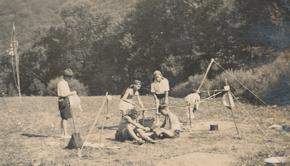 |
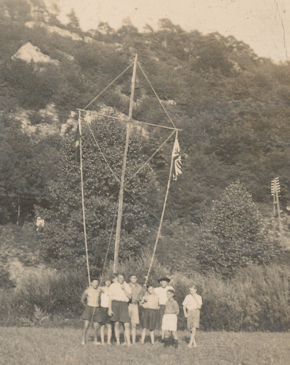 |
ABOVE - CAMP KITCHEN
RIGHT - CAMP FLAG both Gendron-Celles Sur Lesse, Ardennes.
Matters in regard to the 1st Gidea Park came to a head when Cub Pack funds disappeared and the Scout Master was found to be actively encouraging boys to switch from the St Michael's section to the School section and dissuading them from attending the agreed Church Parades. |
F.W. Rowswell and W.Nicholass at once supported the Vicar’s request for a re-registration as a Church Group. Mr Rowswell was to be Group Scout Master (GSM) and Cub Master and Mr Nicholass to be the Scout Master.
This time (1935) though registration as 3rd Gidea Park was grudgingly accorded, the Executive of the Local Association still refused to allow the church to have its own Group in its own hall registered as a sponsored one (or as then styled “controlled”).
By way of compromise however the Vicar was granted the warrant of GSM though he never asked for it, or wanted it, or knew anything about how to fullfill the role. Mr Rowswell was appointed Cub Master (CM) and Mr Nicholass only ASM. The Vicar and the new CM were only too relieved to get “Home Rule” at last; but Nicholass refused to accept anything less than SM and resigned forthwith. In practice Mr Rowswell acted as the GSM and seems to have been semi formally treated as Acting GSM.
So at the end of 1935 F.W. Rowswell found himself sole effective Scouter in the Group being acting SM, as well as CM and acting GSM. This “one-man business” state of affairs lasted more or less continuously until 1944.
1st Gidea Park - The 1st Gidea Park built and opened their own hall Arnaud Lodge in 1938. It was another 35 years before 3GP managed the same. The 1st GP continue to exist as 2nd Squirrels Heath and as of 2015 reside in Hornchurch District. Members of 1st GP did attend 3GP's summer camp in Ireland in 1936 but that was the last joint camp.
2nd Gidea Park - The 2nd Gidea Park was founded by 1928 at Squirrels Heath Methodist Church, by the Drill. The Group transferred to Squirrels Heath District in 1948 and became the 3rd Squirrels Heath. At some stage the Group moved to its own headquarters further North on Upper Brentwood road on the Gidea Park side of the railway. They returned to Romford District in 2015 when Squirrels Heath District was disbanded. For some reason their fate was sealed on the grounds that they were on the Romford side of the railway. Groups on the Hornchurch side of the railway would become part of Hornchurch District. (It was considered a good thing that County had no idea where the 19th and 11th Romford met.)
W.Nicholass was later killed in an accident while on Home Guard duty in 1942.
|
|
|
 |
 |
|
 |
 |
 |
1937 |
|
|
In 1937 the troop gained its first King's Scout badges a fitting celebration for George VI’s Coronation. There were 4 Kings Scouts altogether in the troop of which 3 were accompanied by the very rare Gold Cords, which up to 1947 were awarded to holders of 18 proficiency badges (including the KS of course) The Kings Scouts were A.Ritchie, D. Cornwall, R Murley and C. Caldwell. These four accounted for half the King's Scouts presented in the District that year.
SPANISH SCOUTING
The February 1937 edition of the Essex County quarterly contained an article by F.W. Rowswell about his 1936 visit to Spain. He talks about the challenges of Scouting in Spain at the time. “First there is the universal poverty and illiteracy; few schools exist and, therefore very few Scouts can read more than their name.” He goes on to state, perhaps unfairly that “hygiene is largely unknown and certainly unpractised.”
While there he had to avoid wearing his uniform because as well as being the world Scout emblem, the fleur de lis was the emblem of the Kings of Spain. “Popular feeling was very strong against monarchists and the wearer of such emblems might be misunderstood.”
He describes travelling the 180 miles from Gibraltar to Granada on a train without windows that took 12 hours. Fortunately it was so slow they could safely leave the doors open! For 120 miles he could see "no roads suitable for a car and no other means of transport other than donkeys." All of this makes Scouting and inter district communication quite a challenge although he does note that “Andalusi offers magnificent climbing, hunting, camping and exploring.” What he doesn’t explain is why he chose to visit Scouts in Granada in the middle of a civil war!
The District Challenge Shield for highest proportion of badges (which had been narrowly missed in 1936) was gained in this year and held until 1944.
|
GROUP REPORT FOR 1937 DISTRICT YEARBOOK
3rd GIDEA PARK (St. Michaels)
Undaunted by the absence of an S.M. (or is it because of that?) the Troop has obtained 4 King's Scout badges this year. Two of the holders of these have also gained the Gold Cords, and the others the Red and White. The rest of the Troop has kept up a good average level, being now all Second Class.
New ground has been covered in getting the Airman, Starman and World Friendship badges. We were so delighted to read, on page 13 of the last Scout Pie, that we had come 28th in the County Marathon without even entering a team, that we decided really to compete in the District one this year and see what would happen. The result was that we came third - an improvement !
We enjoyed three holiday camps, in addition to week-ends. First, there was a 10-day camp at Durgan, near Falmouth, in April—an unprecedented event, we were told. Our daring was justified by our five days' dose of sunburn, after a gale had driven us to shelter in a barn. At Whitsun we visited Bedfords Park. In true Scout manner we accepted our A.D.C's challenge to cook his specialities (e.g.: ceufs a la poche d'ecorce d'orange), and are still alive to tell the tale.
Six of us went to the World Jamboree, being put into Troop 110, with Alexandria and Leeds—a Jamboree on its own was this. Further news on application. Finally, to carry out the Chief's message, we embarked on the good ship "Royal Sovereign" one day at Southend and tumbled ashore at Calais, with the object of camping in the Forest of Guines. To our surprise, we were accorded a civic reception in the Town Hall, and were made the guests of the Jamboree Calaisien. The rest you have probably seen already in the Essex Weekly News.
The Cubs, more numerous than ever, got two hard-earned points at the Sports, and a Swimming Medal at the Baths. Camping practice has been shared by them, too.
The Scouters are much depleted in number. Only one, the Old Wolf, has been regularly in action. He manages this Troop and Pack, plus another Troop elsewhere, and is the possessor of a brand new Part I. certificate for the Wood Badge. Meanwhile the G.S.M. gathers enough shekels, not only to construct a new church, but also to provide larger premises for the 3rd G.P.
G.S.M.—Rev. J. ELVIN, St. Michael's Vicarage, Main Road
Meetings—
Scouts, Tuesdays 7.30-10 p.m. C.M.—F. W. ROWSWELL,
Cubs, Thursdays, 6.30 6.308 p.m. A.C.M.—Miss D. REID WILSON (Lone Wolf) Headquarters – St. Michael's Hall, Main Road, Gidea Park
A.S.M.—W. W. KEENE-NICHOLASS, 44, Haynes Rd , Hornchurch
Colours—Khaki shirts, and orange scarves, black bordered, with navy blue jerseys for the Cubs
|
|
|
The Whitsun camp at Bedfords was a District camp. A photo of F.W Rowswell, Cecil Caldwell, Peter Gobey, Alan Rowe and Brian Williams cooking around a fire appeared in the Romford Times.
During 1937 a new Troop was formed at Brentwood School. F.W. Rowswell was a staff member of the School and became Assistant Scout Master of this new Troop in addition to his roles with 3rd Gidea Park. A number of the 3GP Scouts were also pupils at Brentwood School. From then on the two troops regularly camped together. Some of the school pupils were boarders who didn't return home even during school holidays. This situation encouraged lengthy camping trips during school Holidays, trips the 3GP Scouts were all too keen to participate in.
In 1937 the troop camped for the first time on patrol lines, and also for the first time for a fortnight in April. This spring camp was held at Falmouth Cornwall.
5 Scouts (R Murley, C.Caldwell, R Whitaker, Doug Pyne, D. Cornwell) and F.W. Rowswell went to the World Jamboree in Holland. The following report by F.W Rowswell appeared in the District's Scout Pie No. 4.
|
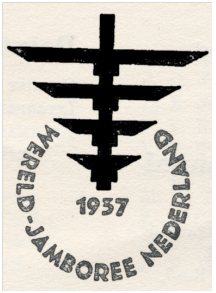 |
The profoundest thanks are due to the Dutch Scouts for the provision of shower-baths, which helped so much to mitigate the tremendous heat. As we were well below sea-level, cut off by sand-dunes from the coast, no sea-breezes came our way.
We were soon afflicted with the usual Jamboree malady - swopping of badges, thirst for autographs of members of other States, and the spending of our hard-earned shekels on clogs,
The general camp-fires in the dunes will never be forgotten. On each occasion some 25,000 people were present.
Some of the programmes were broadcast, though it hardly seemed needful to use radio at all to let the yells or the applause of such an audience be heard all over Holland. Sub-Camp IV. had their own camp-fires too, and one of these was broadcast. Probably the best item in these was the East Indians' dancing; at the final general camp-fire the greatest applause seemed to be given to the Scots' high-speed bagpipe performance, and to the Americans' Eagle Dance.
|
| We did a good deal of exploring on our own, but the chief journeys were made on the last three days, when conducted tours were made of Amsterdam, Volendam and the Zuider Zee, Dordrecht and the river Maas, and Rotterdam and the Hague. What impressed us above all else on these journeys was the spotless cleanliness of the whole country, and the ubiquitous fresh paint. |
|
|
A third camp was held jointly in the forest of Guines, near Calais, France. Among the campers on that trip was F.Godwin who later died during the war. The Group archives contain clippings from three French local newspapers describing the arrival of 3GP in Calais. There is also a note to say there was a brief mention in the Lille newspapers.
On the 29th of October 1937 a young Scout by the name of Peter Roger Hunt passed his Tenderfoot test which would have allowed him to become invested. More of him later.
|
|
|
 |
 |
|
 |
 |
 |
THE PEOPLE OF 3GP - DOUG PYNE |
|
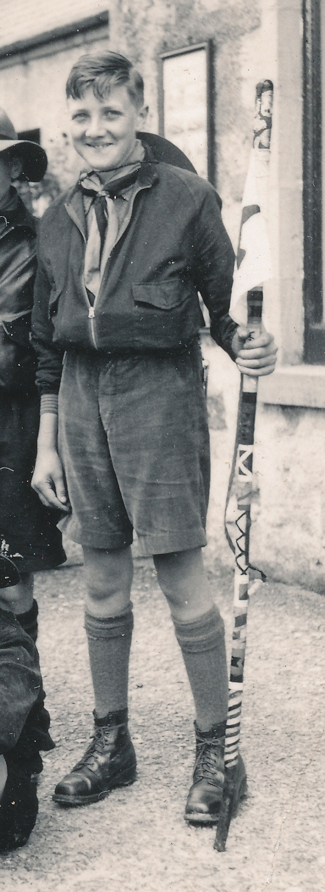 | Douglas Pyne was the 4th cub entered into the Group register. Born on July 11th 1924 he passed his Tenderpad test and joined the cubs in January 1933 aged 8.
He moved on to the Scout Troop in May 1936 shortly before his 12th Birthday.
He was one of five 3rd Gidea Park Scouts to attend the World Scout Jamboree in Holland in 1937.
He was presented with his 2nd class badges by the D.C. Mr Ashby during his inspection of the troop on October 6th 1936.
He passed his 1st class Scout tests in May 1939. He went on to become a Kings Scout and with green and yellow chords in May 1939 and gained the Bushman's Thong in April 1940 and Gold Chords in July 1941. A very accomplished Scout.
He became the Troop Leader in 1940 at the age of 16. He was appointed to the role of Troop treasurer the following year.
On January 19th 1941 he carried District's Kings Colour at a memorial service in St Edwards Romford for Baden-Powell.
In his time as a Scout, between 1936 and 1941 he clocked up over 100 nights camping.
By January 1942 he was our acting Assistant Scout Master and in the November 1943 newsletter he is mentioned as being "now afloat after good results in his Royan Navy course at Portsmouth"
He is later mentioned in the February 1944 group newsletter as Mountaineering on the New York skyscrapers.
By 1947 Doug was a member of the Group Executive Committee. |
|
|
|
 |
 |
|
 |
 |
 |
1938 |
|
|
At Whitsun 1938, 3GP took part in a District camp at Bower Park, Havering. This was a District camp site at the time. A picture of F.W Rowswell, Cecil Caldwell, Peter Gobey, A Rowe and Brian Williams cooking around a fire appeared in the Romford Times and a copy exists in the Group archive. We also appeared on the cover.
In 1938 joint camps were held at Lucano, Switzerland in April; and in July at Great Tower, Windermere. On the way to Lucano, two of our Scouts missed the train from Ostend but managed to complete the journey south with the help of local Belgian Scouts. Reports appeared in two local newspapers at the time.
According to the Group's report for 1938, in order to camp at Great Tower at the time, you needed to be recommended. One of the patrol sites there was for at least 20 years known as “Gidea Glade” after 3GP had cleared it. (Could that be the current Elvan Glade site?) The new Woodpigeon patrol was awarded by the Verderer, Captain Michaelson the “Order of the Second Steak” for toughness in camping under canvas throughout 4 consecutive days of non-stop rain totalling 10 inches. As F.W Rowswell said:
|
This camp taught all the patrols how to camp, for everyone was really on its own: patrol system is really enforced here. We learnt more there about camping than anywhere else before or since. The patrols were camping a mile apart with the Store tent half way between the two. |
We were joined on this camp by G.Szombathy, a Hungarian Sea Scout from Budapest.
One of the more unusual items in the Group Archive is a copy of the London Midland and Scottish (LMS) Railway Restaurant Car menu from the return journey from the Lake District Summer Camp. It has the name of ours and the Brentwood School’s Groups printed on it. Looking at camp reports and plans, pre-booked use of the restaurant car was a common feature of 3GP camps.
The 2019 return from Lake District Summer Camp equivalent for 3rd Gidea Park would be the Leaders buying the Scouts a burger from McDonalds at Watford Gap. How times have changed! Roast lamb and mint sauce is a far more appetising prospect.
The last time the troop had a meal on a train was 2001 coincidentally also on a return journey from Great Towers Scout Camp Site. It was the year of the foot and mouth outbreak and the Leaders suddenly found Virgin Trains offering cheap tickets to encourage travel. The deals were so good that standard class had sold out but fortunately excellent deals for first class were still available. So in 2001 the Scouts travelled in style and enjoyed complimentary and bottomless Virgin Colas as well as sandwiches, crisps and other snacks. I couldn’t say if the Lleaders allowed themselves a complimentary beer to celebrate the end of camp.
|
|
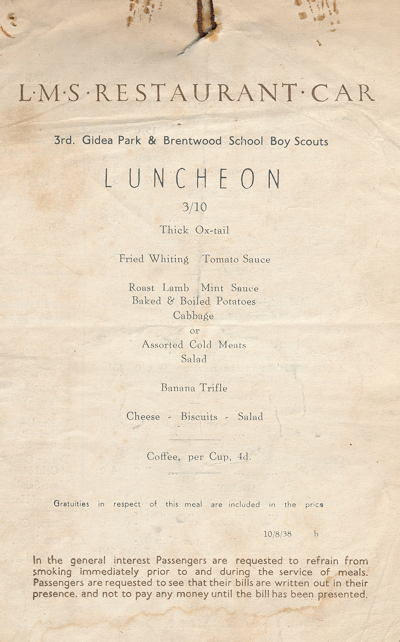
|
|
By the end of 1938 we had 29 Scouts, 20 Cubs and 3 old Scouts. The Scouts had once again been presented with the District Challenge Shield for the gaining of proficiency badges. In our annual report F.W Rowswell was listed as Cubmaster and Acting Scoutmaster. W. Archer was acting Assistant Cubmaster.
|
|
|
 |
 |
|
 |
 |
 |
THE PEOPLE OF 3GP - BILL ARCHER |
|
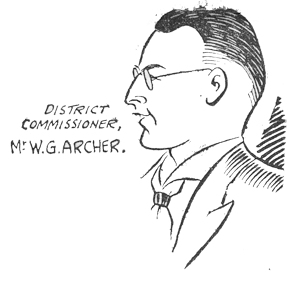 | Mr Archer had been a Scouter in Goodmays and had recently moved to Romford. He only remained a member of 3GP for a few months and became a District examiner 1939. He went on to become District Commissioner in 1948.
The picture on the left was by the illustrator for the Romford Recorder who was covering a district AGM while Bill Archer was DC.
Since 1991, the Bill Archer Shield has been awarded to the Beaver Colony that wins the annual Beaver Scout Sports event. Fittingly 3rd Gidea Park were the first winners.
|
|
|
|
 |
 |
|
 |
 |
 |
1939 |
|
|
The April 1939 camp was held in the French Pyrenees, camping in Pau. During the camp two Scouts achieved distinction by doing their journey abroad for the first class badge. (The fist UK Scouts to do so we believe.) While in France the troop invested the new 1st Pau Troop of Boy Scouts of America.
The Scouts camped in the grounds of an English School - Park Lodge. Local Scouts visited on a daily basis and our visit was covered in local French papers as well as the provincial papers and the Continental Daily Mail published in Paris. Back home reports appeared in the Essex Chronicle and the Romford papers. During the camp, there was an athletics tournament between the School and the English Scouts followed by a camp fire to which the local French Scouts and Guides and many British residents were also invited.
While in France we received a letter from a Spanish Scout interned in a local refugee camp expressing his regret at not being able to attend. One of the English Leaders subsequently wrote to him.
In the summer, the Camp was on the banks of the river Dee, near Balmoral, Aberdeenshire. During the camp we were once again hosts to Hungarian and French Scouts. We hiked Lochnagar (1155m) and Morven (872m) The Morven hike started at 6pm, reaching the summit at about 9:30pm and were back to camp for 01:00am. This wasn't regarded as a night journey as at that time of year twilight persists all night.
|
|
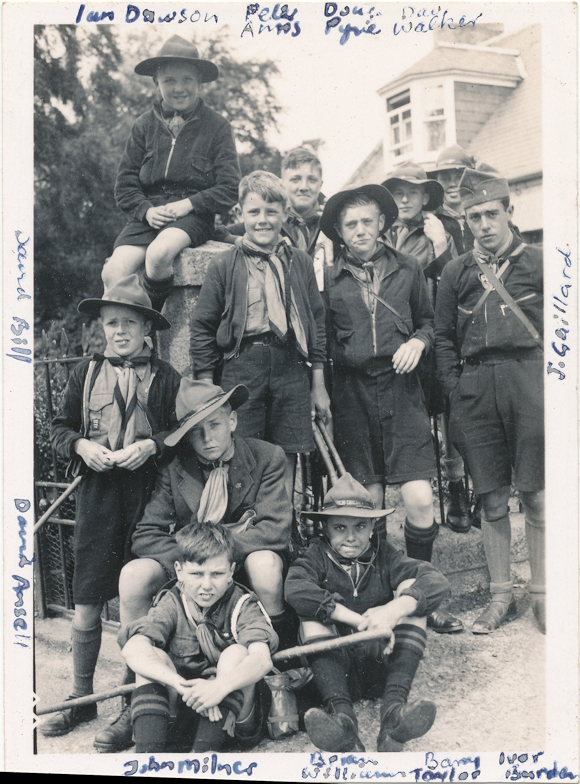
|
The above picture taken on the Scottish camp includes the names of the Scouts annotated in the border. On the right is Jean Gaillard, one of two French Scouts staying with us. Jean was from Paris but we were were also joined by J. Chauvin from Pau and S.Guttmann from Budapest Hungary.
Whilst in Scotland the group also sent representatives to the World Rover Moot at Monzie near Crief. |
|
|
 |
 |
|
 |
 |
 |
THE ST MICHAEL'S GUIDES |
|
|
Rosemary Edwards, our current Brownie leader provided some information about the early days of the Guides at St Michaels.
The Guides first meeting was 1st November 1933. One of the first Guide leaders was Margaret Beddingfield followed by her sister Norms. Like the Scouts, they also met in the small hall, the old Mission Chapel.
The Brownies had their first meeting on 28th July 1937. We think the first Brownie Brown Owl was a Margaret Finch followed by Ruby Beddingfield, Rosemary Pearson took over from her and Rosemary Edwards took over from her. 4 Brown Owls covering 85 years!
There were also Rangers at St Michael's started in the late 1960s by Helen Wethersfield. By the early 1990s Anne and Jill Faithful were running the Rangers by which time it was meeting as Joint unit with the Venture Scouts. By the summer of 1991, Jill and Anne were finding it harder to attend every meeting. It was decided at the Venture Unit AGM to resolve the leadership issue by allowing the Girls to join the Venture Unit.
|
 |
|
As the Rowswell Hall was being built, the Guide Divisional Commissioner, Mrs A.I. Wingham was invited to unveil a commemorative plaque marking the completion of the hall foundations. The ceremony took place after Church Parade where the vicar of St Michaels blessed the concrete slab. Mrs Wingham returned to give a speech at the opening of the hall.
|
 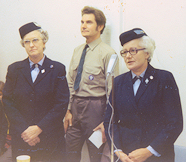
|
|
Over the years the Guides have been in several Districts, they are at present in Gidea Park District, Romford Division, Essex West County and Anglia Region.
|
|
|
 |
 |
|
 |
|







































